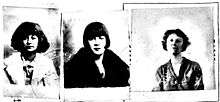Rose Thompson Hovick
Rose Evangeline Hovick (née Thompson; August 31, 1890 – January 28, 1954) was the mother of two famous performing daughters: burlesque artist Gypsy Rose Lee and actress and dancer June Havoc. Her career as her daughters' manager is dramatized in the musical Gypsy.

Life and career
Rose Evangeline Thompson was born in Wahpeton, North Dakota,[1] in 1890,[2] the daughter of Anna (née Egle) and Charles J. Thompson. Her maternal grandparents were German.[2]
Rose Thompson married her first husband, Jack Hovick, when she was a teenager. She gave birth to Rose Louise Hovick on January 8, 1911, in Seattle, Washington, and her second daughter, Ellen June Hovick, in Vancouver, British Columbia, on November 8, 1912. Some sources indicate she was born Ellen Evangeline Hovick in 1913, but Havoc herself acknowledged the earlier year not long before she died.[3] She reportedly had numerous birth certificates for both girls that listed them as being either several years older or younger than they actually were. The former were to evade child labor laws and the latter for reduced or free fares. As a result, for many years, they were never entirely sure of their actual ages.[4][5]
Later in their careers, the two daughters would adopt their more famous stage names, Gypsy Rose Lee and June Havoc. Rose's drive to create a performing career for her daughters eventually led to the end of her marriage to Jack Hovick, who disagreed with her intentions for the girls. Rose married her second husband, Judson Brennerman, a traveling salesman, May 26, 1916 at the Unitarian church in Seattle, Washington, with Reverend J. D. A. Powers officiating.[6]
Many years later, Rose ran both a farm in Highland Mills, New York, and a boardinghouse, some of whose tenants were lesbians, in a ten-room apartment on the seedy West End Avenue in Manhattan.[2] At some point, a young woman by the name of Genevieve Augustine, who was said to be Mother Rose's own lover, allegedly made a pass at the visiting Lee; in a jealous rage, Mother Rose shot the woman dead. This incident was publicly explained as a suicide. After the young woman's mother demanded an investigation, a case was opened, but a jury declined to indict.[7] Mother Rose's biographer strongly refutes the notion that Augustine was Rose's lover and doubts Rose's complicity in her death in light of her previous suicide attempts.[2]
Karen Abbott's biography of Gypsy Rose Lee references two other violent incidents from Thompson Hovick's life. One involved an unidentified "hotel manager" whom Thompson Hovick pushed out a window to his death. She claimed self-defense and was not charged. She also tried to shoot Bobby Reed, the young man who eloped with Baby June in 1928, in a police station after cops found him and brought him to the station house. A police officer had told the two to make their peace. Reed approached with his hand extended, and Thompson Hovick withdrew a concealed gun and aimed it at Reed, but the safety was still on and no bullets were discharged. A policeman tried to hold her, but she broke free and viciously attacked the hapless Reed, punching and scratching him.[7]
Thompson Hovick reportedly continued demanding money and gifts from her daughters until her death in 1954.[8]
"Gypsy"
Thompson Hovick became known as the ultimate stage mother by way of the classic musical Gypsy: A Musical Fable, based on the memoirs of Gypsy Rose Lee. Originally staged in 1959, Gypsy – with music by Jule Styne, lyrics by Stephen Sondheim, and book by Arthur Laurents – has since been performed in countless venues on stage and in film. Both versions portray her as a domineering, take-no-prisoners stage mother who will do anything to further the success of her daughters in show business.
While the character as portrayed in Gypsy is commonly referred to as "Mama Rose" (or "Momma Rose"), this is a sobriquet that does not appear in the script, and was adamantly dismissed by its author, Arthur Laurents. In the musical Gypsy, the character is called Momma, Rose, or Madame Rose.
The role has been portrayed on stage and screen by a number of notable Broadway and film stars, including Ethel Merman in the original 1959 Broadway production of Gypsy, Angela Lansbury in the original London production and a Broadway revival, and Rosalind Russell in the Warner Bros 1962 film Gypsy. Stage revivals have starred Tyne Daly, Linda Lavin, Bernadette Peters, Patti LuPone, Betty Buckley, Leslie Uggams and Imelda Staunton. Lupone's 2008 revival of Gypsy, won her a Tony Award for Best Actress in a Musical, as did Lansbury's 1973 portrayal and Daly's 1990 portrayal. A television movie starring Bette Midler premiered in 1993.
Death
Hovick died of colorectal cancer in 1954, aged 63, in Nyack, New York. She had suffered a stroke two weeks earlier.[2]
References
- Lee, G.R. (1957). Gypsy: A Memoir. North Atlantic Books. ISBN 9781883319953.
- Quinn, C. (2013). Mama Rose's Turn: The True Story of America's Most Notorious Stage Mother. University Press of Mississippi. ISBN 9781617038532.
- "California Death Records". ancestry.com. Retrieved 2014-04-05.
- Karen Abbott (2010) American Rose: A Nation Laid Bare, The Life and Times of Gypsy Rose Lee, New York: Random House; ISBN 1-4000-6691-3; OCLC 608296594
- Laura Jacobs (March 2003) "Taking it all off", Vanity Fair, Vol. 511, p. 198.
- Ancestry.com. Washington, Marriage Records, 1865–2004 from Washington State Archives. Olympia, Washington: Washington State Archives.
- Abbott, Karen (2010). American Rose: A Nation Laid Bare: The Life and Times of Gypsy Rose Lee. New York: Random House. ISBN 1-4000-6691-3. OCLC 608296594.
- Beck, Kathrine K. (April 8, 2004). "Historylink.org". Historylink.org. Retrieved December 22, 2011.
External links
- "The Online Encyclopedia of Washington State History", historylink.org; accessed July 31, 2007.